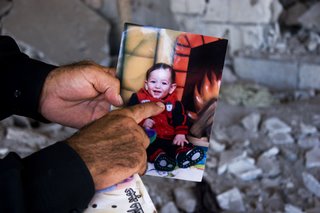Qana Redux, Sept 1st, 2006
Today I went to Qana, a village located southeast of Tyre in southern Lebanon. On April 18th, 1996, during “Operation Grapes of Wrath” Israel shelled a UN compound while fighting Hizbullah forces in the area. About 800 villagers had taken refuge in the compound when fighting broke out. 106 civilians were killed in that attack, and a monument in the village stands in their memory.
On July 27th, 2006, the Israeli Minister of Justice Haim Ramon, said, “Everyone remaining in southern Lebanon will be regarded as a terrorist”.
On July 30th, during “Operation Change of Direction” (a misnomer if there ever was one), another Israel attack killed 27 people from three extended families sleeping on the ground floor of a 4 story building. Israel called the rocket attack a mistake, while also claiming to be shooting at Hizbullah positions nearby. Israeli officials absolved themselves by saying the residents had been warned to leave by leaflets dropped from the sky. An Israeli Army spokesman, Jacob Dalal, said, “Clearly we did not know the civilians were in the way.”
The civilians were not “in the way”. They were huddled on the ground floor of the building when the bombs hit. They had gone to the house because they thought it was the strongest house in the area.
At the time, Dan Gillerman, the Israeli ambassador to the UN, said, “We are dealing with a ruthless, cynical, cruel enemy, one of the most monstrous terror organizations this world has known.” (It should be noted that since the IDF pullout from Lebanon in 2000, and prior to the reinvasion of Lebanon in July 2006, 6 Israeli citizens have been killed by Hizbullah, according to the Israeli Ministry of Foreign Affairs website. In just 2 attacks in Qana alone the state of Israel has been responsible for 20 times more civilian deaths than Hizbullah)
In Qana we met Ahmed Hashem. He slowing walked over to the building that he thought would offer refuge to his family. There was a huge crater and a mound of rubble. He told us how he and his family were trying to sleep when the bombs hit, and how he was blown across the room, into a corner that had not collapsed. He pointed to the overhanging ceiling and told us how the rubble from the blast buried everyone. As the bombs continued falling, no one could escape and no one could come to help. They began digging victims out by hand. In the morning the Red Crescent arrived, for most of the victims it was too late.
Ahmad and I crouched in the dust, and he took some pictures from an envelope. His wife, his father, his three young sons, his five nephews. His hand lingered over the picture of his youngest son, his fingers tracing the smiling face.
I have been advised that it is a sad fact that in any war, civilians are killed. We call their deaths regrettable, but necessary. We call it “collateral damage” to distance ourselves from the pain suffered by people in far away places, without names or faces. We dehumanize the victims in order to accept their deaths by our guns and bombs. We blame the “enemy”, we blame the “intelligence”, we blame the victims for "being in the way", searching ceaselessly to place the consequences of our actions outside ourselves. We rationalize, justify, and explain away the lives of innocents in such an easy, reckless manner. Politicians encourage this, making lofty pronouncements about the great things to come after the war is won; the defeat of terrorists; and the necessity to stay the course, less evil win. Crouching in the dust of Qana, watching Ahmed trace the lines of his darling boy's face, I pause to reconsider.
skip to main |
skip to sidebar


Whitehouse Arrest for Protesting the Occupation of Iraq (Sept 2005).



Sharon, Blair, Bush... Terrorists; Abu Dis (Mar 2005)

Balls to Walls; Abu Dis (Mar 2005)

Arrested Bringing a Coffin to Congress (Sept 2006)
All the universe is one bright pearl- we do not speak of two pearls or three pearls...your whole body is a radiant light. Your whole body is Mind in its totality...your whole body knows no hindrance. Everywhere is round, round, turning over and over.
Support My Work!

- Johnny
- i am a human rights activist, writer, photographer, and videographer. i have traveled to Afghanistan, Iraq, Lebanon, Jordan, Syria, and Palestine (the West Bank & Gaza), to bear witness and document the effects of war on communities and the struggle to retain human dignity in the face of oppression. i advocate for justice, reconciliation, and nonviolent strategies in the face of violence and oppression.

Whitehouse Arrest for Protesting the Occupation of Iraq (Sept 2005).



Sharon, Blair, Bush... Terrorists; Abu Dis (Mar 2005)

Balls to Walls; Abu Dis (Mar 2005)
Links

Arrested Bringing a Coffin to Congress (Sept 2006)
